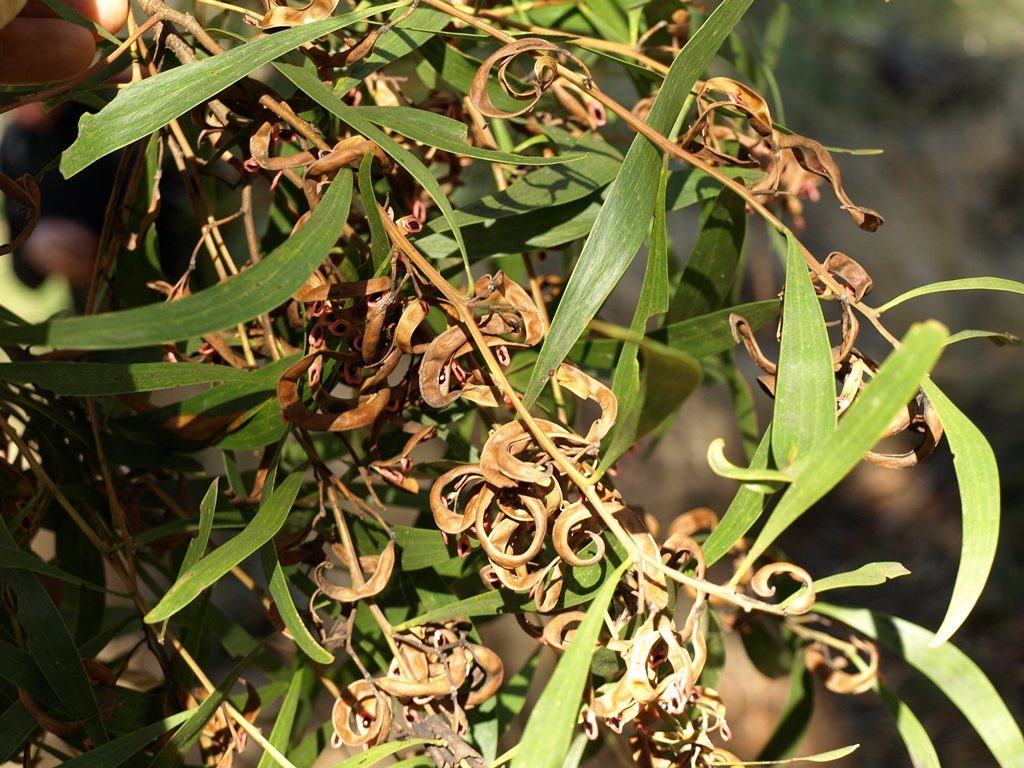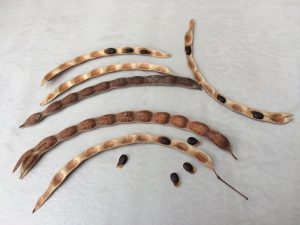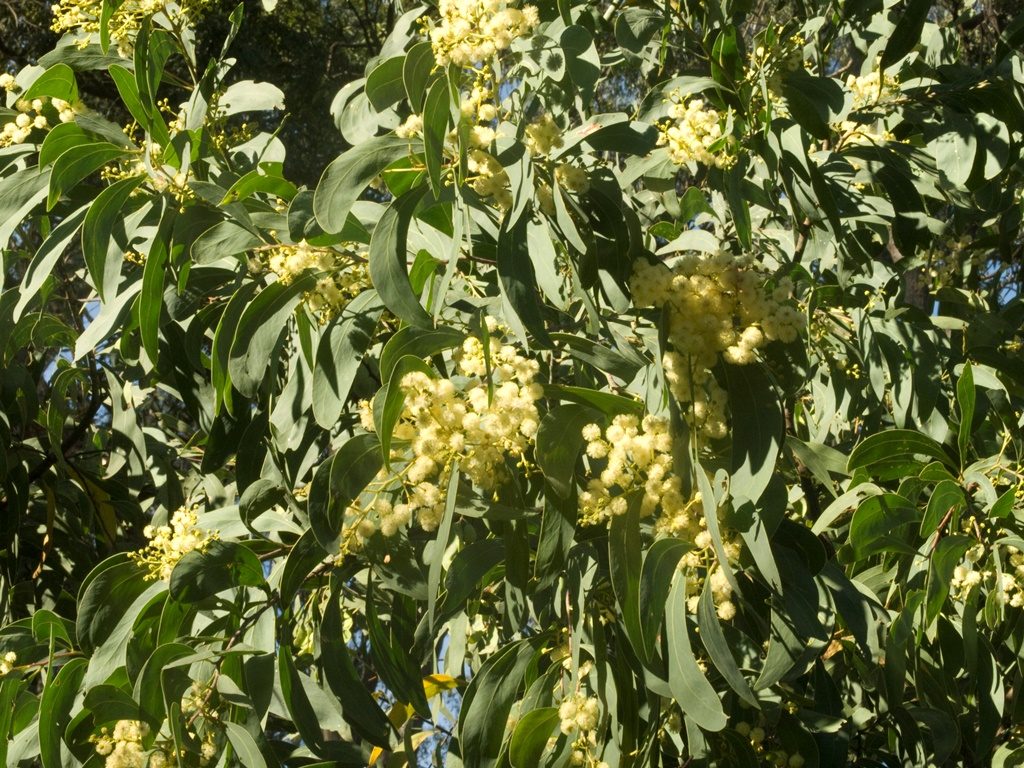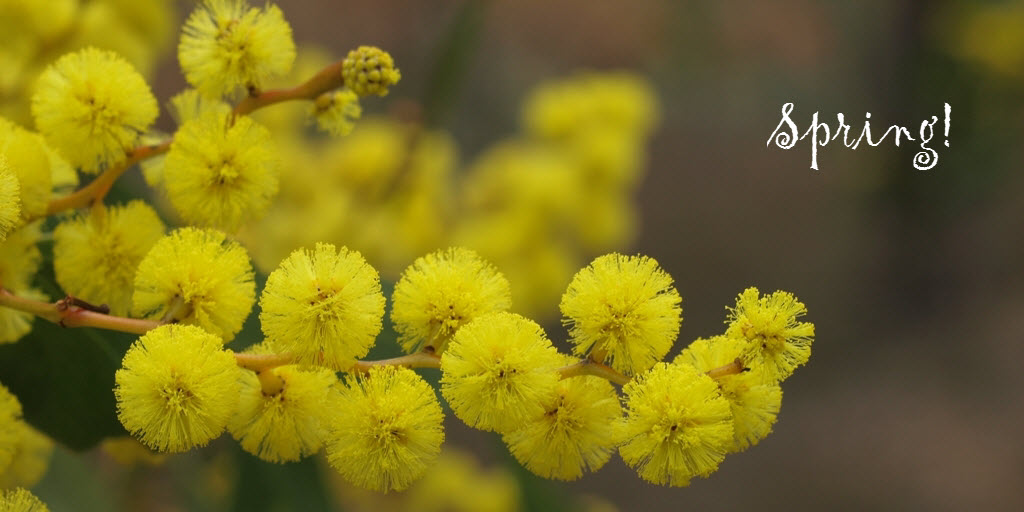Wattles are easy to grow and maintain
It’s easy to grow wattle trees from seed. Wattles are great garden plants and most put on a spectacular display when they flower.
As there are so many species of wattles in Australia, it is not hard to find a suitable one for your garden, no matter where you are in Australia.
Their growth form varies from low groundcovers (for example, forms of Acacia cognata, Acacia glaucoptera) to small shrubs (for example, Acacia flexifolia), medium shrubs and large shrubs (most species), to large trees (for example, Acacia bakeri).
Most wattles are very hardy. In nature, they are often pioneer species that germinate from seed present in the soil’s seed bank. They grow up quickly in areas that have become open after a disturbance or a fire. This means that wattles can quickly germinate in large numbers and provide a green cover that will protect other plants and animals. This characteristic is very handy in the garden too!
Because wattles grow fast, they are best purchased as young plants or grown from seed. By planting wattles when they are young, they will develop a good root system immediately in the soil. When grown in pots until they are older, the plants will often become pot-bound and have a hard time to develop a good root system once they are planted.
[wc_center max_width=”500px” class=”” text_align=”left”][wc_box color=”inverse” text_align=”left” margin_top=”” margin_bottom=”” class=””]QUICK LINKS:
- How to grow wattle trees from seed?
- Which wattle to grow where?
- Wattles attract wildlife to the garden
- What is the ecological role of Australian wattles?
- Aboriginal uses of Australian wattles
- Australian National Herbarium drawings
[/wc_box]
[/wc_center]
How to grow wattle trees from seed?
It’s easy to grow wattle trees from seed:
- Collect ripe seed pods from the tree or shrub.
- Poor hot water over the seeds and let stand overnight.
- Place the seed in damp paper towels in a closed container in a dark place until it germinates.
- Sow the germinated seed in a pot with 1/4 coco peat and 3/4 sand mix at 0.5 cm depth.
Collecting seed
The pods with ripe seed will be on the plant about three to three to six months after flowering. However, the time to maturity can vary significantly between species.
The best sign that the seed is ripe is when seedpods dry up and turn brown. Seeds will certainly be ripe when the pods split open, but many seeds will have fallen to the ground already. Therefore, you need to keep an eye on the pods and pick a time just before the pods will crack open.

Remember, you cannot collect seed from the bush! If you do want to collect wild seed, you will need a permit from your state authority. However, wattles are very common in people’s gardens, and so there should be no problem to ask your neighbour to give you some seed of a wattle you may admire.
Once collected, place the seed pods in dry sunny spot and wait for them to split open and release their seed.

Preparing the seed
Wattle seeds have a very tough outer seed coat that does not let water through. This is useful for the seed, which has to remain in a dormant state in the ground over many months and years while waiting to germinate successfully when conditions are good.
However, this means that if you want to grow wattle trees from seed at home, you need to treat the seed with a pre-germination seed treatment method. There are various treatment methods that will make the seed coat let water through and induce germination.
After removing the seed from the pods, apply a pre-germination seed treatment to get the seed to germinate. The most often used method for wattles is the hot water method. However, some wattles cannot handle long immersion in boiling water, so try out the physical scarification method on some of the seed to make sure you do not destroy all your seeds.
Growing seedlings in pots
Once the seeds have been treated, you can use a standard seed germination method to get germination. Then, sow the germinated seed in a pot with 1/4 coco peat and 3/4 sand mix at 0.5 cm depth.
To grow your seedling in the pot:
- Water the seedling regularly and keep it in a sheltered location with good lighting, but no direct sun.
- Grow the seedling until it has a good root system that will allow it to survive in the ground. Start hardening off the plant by gradually placing it in more sun as it gets stronger.
Many wattles will grow quite fast. Make sure to use pots with root trainers when potting up.

Which wattle to grow where?
You can grow a wattle in any garden, even if you only have a few square metres of garden. There are wattles in all sizes and shapes: groundcovers, small to large shrubs, and even large trees. Make sure to check the preferred conditions of a species before you plant it.
After planting, water regularly until you can see that the plant has produced new leaves while in the ground. Then water less and gradually let it get used to the natural rainfall of your region. When you plant a local wattle, they should be able to thrive in those conditions.
The following wattles are suitable for small gardens in south-eastern Australia:
- Acacia acinacea (prostrate forms)
- Acacia cardiophylla ‘Gold Lace’
- Acacia cognata ‘Mini Cog’
- Acacia cultriformis ‘Cascade’
- Acacia pravissima ‘Golden Carpet’
There are many, many shrub-size wattles to choose from (from 1 m tall small shrubs to large shrubs of 5 m to 6 m). The best way to choose is to look at the plants that grow in your local area or in the wider surrounding area.
Here are some tips for the various states. Once you have found the list for your area, look up the species in the Atlas of Living Australia.
Australian Capital Territory wattles
Here are some of my favourites for the Australian Capital Territory region:
Acacia acinacea, Acacia alpina, Acacia aspera, Acacia boormanii, Acacia buxifolia, Acacia cultriformis, Acacia dawsonii, Acacia dealbata, Acacia deanei, Acacia decurrens, Acacia doratoxylon, Acacia elongata, Acacia falciformis, Acacia genistifolia, Acacia gunnii, Acacia lanigera, Acacia mearnsii, Acacia melanoxylon, Acacia obliquinervia, Acacia paradoxa, Acacia parramattensis, Acacia penninervis, Acacia pravissima, Acacia pycnantha, Acacia rubida, Acacia semibinervia, Acacia siculiformis, Acacia ulicifolia, Acacia verniciflua.

For more information on wattles for the Canberra region, try this publication: Australian plants for Canberra region gardens.
New South Wales wattles
The Royal Botanic gardens, Sydney has an excellent list of recommended NSW wattles for various regions in (cool-dry, cool-humid, warm-dry and warm-humid areas). The list is grouped by growth form and provides and excellent resource if you need to choose a wattle for your garden!
Australia-wide wattles
The best source of information to choose wattles for your garden is Australian native plants by John Wrigley and Murray Fagg. This lists many wattles that are currently available in nurseries and locally.
Wattle identification
If you are keen to try and identify some of your local wattles, try one of the local field guides I have listed to the right of this post. If you are a keen botanist, have a look at WATTLE Acacias of Australia, an online database that can help you identify wattles. However, be warned, this is not an easy tool to use …
[wc_box color=”primary” text_align=”left” margin_top=”” margin_bottom=”” class=””]
Did you know?
- Wattles belong to the plant genus Acacia, which is a member of the legume, pea, or bean family (Fabaceae).
- The genus Acacia, has a world-wide distribution, but 98% of the Australian wattles only occur in Australia. That is a very high percentage of unique (Endemic) species only found in Australia.
[/wc_box]
Wattles attract wildlife to the garden
Wattles may attract a variety of wildlife to your garden: possums, kangaroos and wallabies, sugar gliders, birds and insects. Kangaroos, wallabies and other marsupials may eat the young wattle leaves. These animals may also seek shelter under wattles.
Some birds, like parrots and pigeons, will eat the wattle pods and seeds. However, honeyeaters, silvereyes, thornbills and wrens will visit the wattles to eat insects. Even arboreal reptiles (like dragons, skinks or geckos) visit wattles to find insects for food.
The denser and prickly wattles are great for small birds, who use them to seek shelter and build their nests in them.
The wattle fruit is a small to large pod, with often large seeds. Therefore, parrots and other seed- or pod-loving birds will be attracted when the seedpods are tasty for them. Some birds seem to like the young green pods, while others like the nutty ripe seeds.
Read also: How to create a wildlife-friendly garden
What is the ecological role of Australian wattles?
Wattles are experts at extracting nitrogen from the air, as their roots host nitrogen-fixing organisms, which then contribute usable nitrogen to the soil (read more about this in Nitrogen fixation in acacias).
Because wattles grow very quickly after a disturbance, they provide shelter for other plant species that grow slower. At the same time they also provide food and shelter for animals.
Aboriginal uses of Australian wattles
These sites have excellent information on how the first Australians use or used wattles:
- Australian National Botanical Gardens: Aboriginal use of wattles
- Acacia in Australia: Ethnobotany and Potential Food Crop, Peter R Lister, Paul Holford, Tony Haigh, and David A. Morrison
Australian National Herbarium drawings
Acacia aphylla Acacia ashbyae
Acacia binervata Acacia complanata
Acacia decurrens Acacia ingramii
Acacia longifolia Acacia prominens
Acacia pycnantha Acacia glaucescens
Leave a comment
If you like this post, please leave a comment. How do you grow wattle trees from seed? Do you have any other recommendations? Or any questions?



how can I gets seeds
Hi Stephen
You can find pods with ripe seed on trees or shrubs a few months after flowering. You can also buy seed from native plant nurseries or native botanic gardens.
Great little article. Good detail for seed collection. I just had a successful collection of qld silver wattle from a neighbourhood tree. Last year I got 5 germination from 10 seeds bought of eBay, so was keen to read if I could sow straight from collection (ie. no period of dormancy required) and all looks good from the notes. Do please stipulate if a time of dormancy is required. From the 5 germination only 2 are mature plants and are growing well, especially now they are in taller pots.
Last years seeds were a little perplexing in the development of the germination leaves to phyllodes to maturity. Some notes on this would be great.
Thanks Christabel!
Dormancy is common in many Acacias. Both pre-germination seed treatment methods (the hot water method and the physical scarification method) work to break this dormancy. You can also combine two methods by soaking the seeds first and then scarifying them. With so many species of Acacia, I’m afraid you will need to experiment a bit to find which method works best. Good luck and let us know what you have learned by making another comment!
Also, as you have discovered, many Acacias with phyllodes start off with a few (or sometimes several) pinnate first leaves when they germinate, which can be confusing!
I like your clear information. I will try both ways. I collected enough seed to try scattering but I was advised by a nurseryman to wait until autumn. My question is how should I store the seed throughout our humid hot summer? Live on north NSW coast. Thanks.
Thanks Jill!
Before storing your seed through a hot and humid summer, you first need to dry it.
This may not be so easy in a hot and humid climate.
However, you could dry the seed by:
– placing it a well-ventilated area using a fan to circulate air
– placing it in an air-conditioned room
– placing it over a desiccating silica-gel bag (the small bags you sometimes find in medication or other products that need to be kept dry) in a sealed container.
Once dry, place the seed in an airtight container at room temperature; or, if you think even that may be too hot, place it in the fridge (not freezer).
All the best with your experimenting!
I recently had a tree identified as Acacia melanoxylon , growing in a tall pot I have in my courtyard after my limelight suddenly died 😖
Apparently the limelight was a grafted specimen and this is the rootstock which it was grafted on to.
I’m told it is an undesirable tree so would suggest removing. My question is what if I left it pot bound?
Hi Jill
Yes, Limelight is grafted onto a stock of Acacia melanoxylon. I am not sure why you were told this is an undesirable tree. It is a very nice tree that is long lived. This probably means that if you keep it as a pot plant, it may need regular pruning to keep it small.
I have not tried myself to grow acacias in pots once they are mature, so I cannot advise you on that. However, I have seen Acacia melanoxylon used as a bonsai. This means it is certainly possible to try growing it in a pot. So, have a go and let us know how it works out 🙂
Thanks for the article. When I lived in Melb I collected seeds from a wattle in Glen Iris. I now want to grow them. Your article is a great help. I am now in fire ravaged East Gippsland, and hope to get locals planting some in their gardens. Cheers.
Hi Pam
That is great. Growing wattles is very satisfying.
If you would like more information about the plants that are native to the area in East Gippsland, this is a great site: https://rbgvictoria.github.io/vicflora-static-pages/bioregions/east-gippsland#vegetation
Wattles are often some of the first woody plants that germinate spontaneously in nature after fire — they are therefore important for the recovery of the vegetation.
All the best!
Hi all , can you collect the pods while green and let them ripen .
Thanks.
Hi Leah
It is very unlikely that green seed pods will have seed that is viable. Seeds will not continue to ripen inside the green pod after it has been removed from the plant. The best way to harvest Acacia seed is to wait until at least some of the seedpods on the plant have opened and released their seed. At that stage it is more likely that other unopened pods on the plant also have ripe seed.
My seeds went mouldy while waiting for them to germinate. What did I do wrong? One has a white piece coming out of the seed, has it germinated? Thank you 😊
Hi Rachel
Perhaps you forgot to cover the seeds with a thin layer of soil? Or perhaps you applied too much water?
If you see a white ‘piece’ coming out of the soil, that may well be a first root. Cover the seeds with a thin layer of soil and apply regular water, but make sure no water remains sitting on the surface for a long time. That would mean the soil has become too wet, which may indeed cause mould.
If you think the soil is too wet, just stop the watering for a while until the top surface has dried out. After a few days of being dry, you can just start watering again. It is important that the seeds stay moist but not wet.
Good luck!